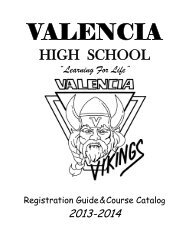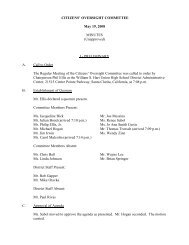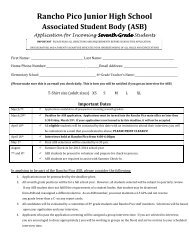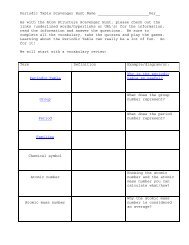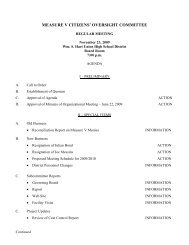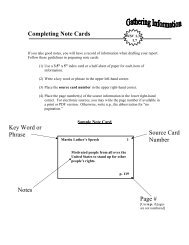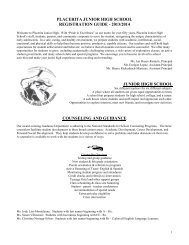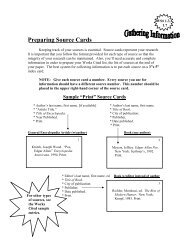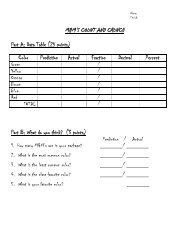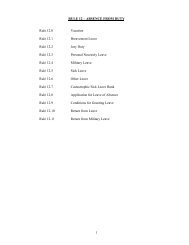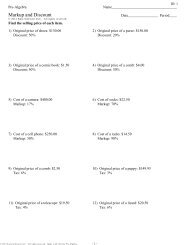The Art of Composition: Writing the Essay
The Art of Composition: Writing the Essay
The Art of Composition: Writing the Essay
You also want an ePaper? Increase the reach of your titles
YUMPU automatically turns print PDFs into web optimized ePapers that Google loves.
<strong>The</strong><br />
<strong>Art</strong> <strong>of</strong><br />
<strong>Composition</strong>:<br />
<strong>Writing</strong> <strong>the</strong> <strong>Essay</strong>
Structuring <strong>the</strong> <strong>Composition</strong><br />
WS# 1.4<br />
<strong>Composition</strong>s are structured much like individual paragraphs. <strong>The</strong>re are clear introductory and<br />
concluding elements. However, compositions are a series <strong>of</strong> paragraphs that attempt to<br />
communicate a main idea that cannot be sufficiently developed in one paragraph.<br />
Hook<br />
Introductory<br />
Material<br />
<strong>The</strong>sis Statement<br />
Concluding statements<br />
Unlike an individual paragraph, <strong>the</strong><br />
clinching statement <strong>of</strong> a composition<br />
paragraph should do one or more <strong>of</strong> <strong>the</strong><br />
following:<br />
• Restate main idea <strong>of</strong> paragraph<br />
• Connect paragraph main idea with<br />
composition <strong>the</strong>sis<br />
• Restate main idea <strong>of</strong> paragraph<br />
and transition into / setup next<br />
paragraph main idea<br />
Topic Sentence<br />
Supporting Details<br />
Clincher Sentence<br />
<strong>Composition</strong> Paragraphs<br />
Like individual paragraphs,<br />
composition paragraphs should<br />
be organized in some way to<br />
support <strong>the</strong> main idea <strong>of</strong> <strong>the</strong><br />
larger piece <strong>of</strong> writing.<br />
Typical functions, or purposes, <strong>of</strong><br />
<strong>the</strong>se paragraphs are generally one <strong>of</strong> <strong>the</strong><br />
following:<br />
• explain or inform<br />
• narrate a story / anecdote / analogy<br />
• describe events, persons, activities<br />
• define<br />
• persuade<br />
• transition from one subject to <strong>the</strong><br />
next<br />
Restatement <strong>of</strong><br />
<strong>the</strong>sis<br />
Review main ideas<br />
Provide closure – a<br />
final thought<br />
Extending Your Ideas<br />
<strong>The</strong> conclusion should make a lasting<br />
impression while providing a sense <strong>of</strong><br />
completeness. <strong>The</strong> final thought(s) should<br />
extend from <strong>the</strong> points discussed in <strong>the</strong> body <strong>of</strong><br />
your writing.<br />
2<br />
Created by M. Smith & C. Tolisano
A Closer Look: <strong>The</strong> Introduction<br />
WS# 1.1<br />
<strong>The</strong> introduction is a unique paragraph because it must prepare <strong>the</strong> reader for <strong>the</strong> text that will<br />
follow. It should accomplish each <strong>of</strong> <strong>the</strong> following:<br />
(1) Catch <strong>the</strong> interest <strong>of</strong> <strong>the</strong> audience<br />
(2) Clearly indicate <strong>the</strong> topic and purpose<br />
(3) Establish <strong>the</strong> tone <strong>of</strong> <strong>the</strong> composition<br />
GENERAL STATEMENT<br />
• HOOK<br />
• TRANSITION<br />
• THESIS<br />
SPECIFIC<br />
THESIS STATEMENT<br />
SPECIFIC<br />
THESIS STATEMENT<br />
Hooking <strong>the</strong> reader …<br />
Anecdote / Example<br />
Use a brief personal story / example that leads naturally to <strong>the</strong><br />
<strong>the</strong>sis statement.<br />
GENERAL STATEMENT<br />
Contradictory Statement<br />
Begin with a statement that contradicts your <strong>the</strong>sis in order to interest <strong>the</strong> reader.<br />
General Background Knowledge<br />
Provide background knowledge when it might be helpful to an audience that is not<br />
familiar with your topic.<br />
Question<br />
Although this technique should only be used as a last resort or unless <strong>the</strong> topic truly<br />
warrants it, ask a question that requires more than a “yes” or “no” response that will<br />
encourage your audience to continue reading.<br />
Direct Quotation<br />
Use a passage or text or a comment from someone notable to introduce <strong>the</strong> general<br />
topic and connect it with your <strong>the</strong>sis statement.<br />
3<br />
Created by M. Smith & C. Tolisano
Constructing a <strong>The</strong>sis Statement<br />
WS# 1.1<br />
A <strong>the</strong>sis statement is <strong>the</strong> controlling idea <strong>of</strong> a composition. It states <strong>the</strong> main idea(s) <strong>of</strong> <strong>the</strong><br />
writing while establishing <strong>the</strong> tone.<br />
IN A SINGLE SENTENCE, THE THESIS STATEMENT DECLARES THE<br />
MAIN SUBJECT AND A FEELING/ATTITUDE ABOUT THAT SUBJECT.<br />
Subject<br />
+ Specific =<br />
Feeling<br />
<strong>The</strong>sis Statement<br />
<strong>Writing</strong> a <strong>The</strong>sis Statement<br />
subject (Cancún, Mexico’s metamorphosis from drowsy fishing village to<br />
vacation paradise)<br />
+ a specific feeling about <strong>the</strong> subject (is a simple story <strong>of</strong> determination and luck )<br />
= an effective <strong>the</strong>sis statement<br />
<strong>The</strong>sis Statement: Cancún, Mexico’s metamorphosis from drowsy fishing village<br />
to vacation paradise is a simple story <strong>of</strong> determination and luck.<br />
Defining Your Subject<br />
1. Consider <strong>the</strong> information that you have ga<strong>the</strong>red and decide what specifically you would<br />
like to discuss in your research.<br />
<strong>the</strong> metamorphosis <strong>of</strong> Cancún, Mexico, from a drowsy fishing village to a vacation<br />
paradise<br />
2. Put your idea into a form <strong>of</strong> a question.<br />
What type <strong>of</strong> metamorphosis took place in Cancún, Mexico?<br />
3. Now turn your question into a sentence that states exactly what you would like to declare<br />
about your subject.<br />
Cancún, Mexico’s metamorphosis from drowsy fishing village to vacation<br />
paradise is a simple story <strong>of</strong> determination and luck.<br />
4<br />
Created by M. Smith & C. Tolisano
Evaluating a <strong>The</strong>sis Statement<br />
WS# 1.1<br />
<strong>The</strong>sis Structure<br />
(1) Develop your <strong>the</strong>sis from information ga<strong>the</strong>red.<br />
(2) Include both a limited topic as your subject and <strong>the</strong> specific feeling you have<br />
about <strong>the</strong> topic as your main idea.<br />
(3) Be clear and specific.<br />
(4) Use parallel structures.<br />
(5) Keep your <strong>the</strong>sis in front <strong>of</strong> you as you write.<br />
<strong>The</strong>sis Do's<br />
(1) Must be an opinion.<br />
(2) Must have 2 or 3 points that will be developed.<br />
(3) Must be supported with research or o<strong>the</strong>r types <strong>of</strong> support.<br />
<strong>The</strong>sis Review<br />
How well <strong>the</strong> writer has focused on and supported his or her <strong>the</strong>sis determines <strong>the</strong><br />
quality <strong>of</strong> a paper. A good <strong>the</strong>sis statement can answer yes to <strong>the</strong> following:<br />
<br />
<br />
<br />
<br />
Does your <strong>the</strong>sis clearly define a specific opinion on some subject?<br />
Is <strong>the</strong> <strong>the</strong>sis stated in a clear, direct sentence?<br />
Is your <strong>the</strong>sis supported by <strong>the</strong> information you have ga<strong>the</strong>red?<br />
Is your <strong>the</strong>sis located as <strong>the</strong> last sentence in <strong>the</strong> introductory paragraph?<br />
Statements to Avoid<br />
(1) DON'T make your <strong>the</strong>sis merely an announcement <strong>of</strong> your subject matter<br />
or a description <strong>of</strong> your intentions. DO NOT use phrases like "I'm going to write<br />
about . . ." or "This paper is about . . . .”<br />
(2) DON’T clutter your <strong>the</strong>sis with expressions such as “in my opinion,” “I believe,”<br />
and “I think that . . . .”<br />
5<br />
Created by M. Smith & C. Tolisano
Establishing Tone<br />
WS# 1.0<br />
<strong>The</strong> attitude a writer takes toward his or her characters, subject, or<br />
readers is called tone. Just as a person speaks in a certain tone <strong>of</strong><br />
voice, written text also conveys, or expresses, a tone.<br />
<strong>The</strong> tone <strong>of</strong> a text may be critical, detached, angry, or respectful -<br />
whatever fits its subject and message. <strong>The</strong> writer can establish a tone<br />
through <strong>the</strong> use <strong>of</strong> imagery and figurative language such as similes, metaphors, and<br />
personification. Word Choice, or diction, though, is <strong>the</strong> foundation <strong>of</strong> a writer's tone. <strong>The</strong><br />
writer's use <strong>of</strong> language, as well as <strong>the</strong> connotative responses to that language, powerfully<br />
emphasizes <strong>the</strong> effect a writer has on his or her readers.<br />
<br />
<br />
<br />
<br />
<br />
<br />
<br />
Specific language<br />
- action verbs<br />
- precise nouns<br />
- vivid adjectives / adverbs<br />
Sensory details<br />
Figurative Language<br />
- similes<br />
- metaphors<br />
- personification<br />
- hyperbole<br />
Dialogue / Dialect<br />
Slang<br />
Verbal informal language<br />
- contractions<br />
- clichés<br />
Written formal language<br />
- standard grammar / mechanics<br />
Connotation<br />
<strong>The</strong> connotation, or emotional<br />
association, that words carry<br />
with <strong>the</strong>m is a powerful tool in<br />
creating a tone. Two words can<br />
have <strong>the</strong> same denotation, or<br />
dictionary meaning, but one<br />
may be more positive or<br />
negative than <strong>the</strong> o<strong>the</strong>r may.<br />
Consider <strong>the</strong> difference in <strong>the</strong><br />
words proud and arrogant, both<br />
<strong>of</strong> which mean "full <strong>of</strong> pride."<br />
6<br />
Created by M. Smith & C. Tolisano
Using Descriptive Language<br />
WS# 1.2,<br />
1.9<br />
Language is power! Using specific language to describe your world or explain yourself makes<br />
it easier for your audience to grasp your vision. Whe<strong>the</strong>r you are speaking to someone or<br />
writing about some aspect <strong>of</strong> a topic, use precise nouns, action verbs, vivid modifiers<br />
(adjectives, adverbs, comparisons), and sensory words to capture your audience's attention and<br />
to make your communication more lively.<br />
PRECISE NOUNS<br />
GENERAL<br />
monster animal rain<br />
SPECIFIC<br />
vampire amphibian storm<br />
MORE<br />
SPECIFIC<br />
Count Dracula bullfrog hurricane<br />
VIVID ADJECTIVES / ADVERBS<br />
Make your modifiers livelier!<br />
funny → amusing → hilarious<br />
heavy → weighty → ponderous<br />
well → adequately → expertly<br />
ACTIVE VERBS<br />
Maintain an active voice in your writing by choosing verbs that are descriptive.<br />
dashes or darts<br />
sauntered or lumbered<br />
instead <strong>of</strong> runs quickly<br />
instead <strong>of</strong> walked slowly<br />
SENSORY WORDS<br />
Use words that appeal to <strong>the</strong> five senses:<br />
Sight: maroon, globular, flashy, radiant, serene<br />
Sound: clamor, gurgle, giggle<br />
Taste: tangy, ripe, peppery<br />
Smell: aromatic, dank, pungent<br />
Touch: crisp, gritty, damp<br />
7<br />
Created by M. Smith & C. Tolisano
Integrating Direct Quotations<br />
WS# 1.6<br />
Anytime you directly use ano<strong>the</strong>r writer’s words to support your conclusion, you are citing<br />
evidence, or quoting a source. This use <strong>of</strong> text passages, lines, or words can be integrated into<br />
your essay in one <strong>of</strong> <strong>the</strong> four ways.<br />
(1) Incorporated into <strong>the</strong> Sentence<br />
A creator always has an obligation to <strong>the</strong> thing he creates. This is clearly shown<br />
in <strong>the</strong> epigraph from Mary Shelley’s Frankenstein in which <strong>the</strong> monster seemingly cries<br />
out, “Did I request <strong>the</strong>e, Maker, from my clay to mould me Man? Did I solicit <strong>the</strong>e from<br />
darkness to promote me…?” (4). At his creation, <strong>the</strong> monster is a….<br />
• Mark omission <strong>of</strong> <strong>the</strong> text by three periods (called an ellipsis) with a space<br />
between each (. . .).<br />
(2) Set-Up by <strong>the</strong> Previous Statement<br />
A creator always has an obligation tot he thing he creates. Mary Shelley clearly<br />
shows this in <strong>the</strong> epigraph for Frankenstein, an epigraph that reflects <strong>the</strong> monster’s<br />
point <strong>of</strong> view: “Did I request <strong>the</strong>e, Maker, from my clay to mould me Man? Did I solicit<br />
<strong>the</strong>e from darkness to promote me…?” (4). At his creation, <strong>the</strong> monster is a….<br />
• Just giving a citation is not enough. You must say something about it before<br />
and after <strong>the</strong> citation.<br />
• <strong>The</strong> colon is used after a COMPLETE sentence.<br />
(3) Set Apart from <strong>the</strong> Main Text<br />
A creator always has an obligation to <strong>the</strong> thing he creates. As an epigraph for<br />
Frankenstein, Mary Shelley chose <strong>the</strong> following lines from Million’s Paradise Lost that<br />
reflect <strong>the</strong> creature’s point <strong>of</strong> view: “Did I request <strong>the</strong>e, Maker, from my clay to mould<br />
me Man? Did I solicit <strong>the</strong>e from darkness to promote me…?” (4). <strong>The</strong> constant pleas <strong>of</strong><br />
<strong>the</strong> monster itself, though, provide <strong>the</strong> strongest evidence <strong>of</strong> <strong>the</strong> creator / creation<br />
obligation:<br />
How can I move <strong>the</strong>e? Will no entreaties cause <strong>the</strong>e to turn a<br />
favourable eye upon thy creature, who implores thy goodness and<br />
compassion? Believe me, Frankenstein: I was benevolent; my soul<br />
glowed with love and humanity: but am I not alone, miserably alone?<br />
You, my creator, abhor me; what hope can I ga<strong>the</strong>r from your fellow<br />
creatures, who owe me nothing? (100)<br />
At his creation, <strong>the</strong> monster is a….<br />
• When quoting more than 4 lines, skip a line and double-indent<br />
• Continue your paragraph without indenting<br />
8<br />
Created by M. Smith & C. Tolisano
Integrating Direct Quotations - Poetry<br />
WS# 1.6<br />
(4)Lines <strong>of</strong> Poetry<br />
Incorporating citations from poetry is very similar to <strong>the</strong> methods used to integrate<br />
prose. Make note <strong>of</strong> <strong>the</strong> following examples:<br />
Example A<br />
<strong>The</strong> first stanza <strong>of</strong> Edgar Allan Poe’s “<strong>The</strong> Raven” provides <strong>the</strong> starting point<br />
for <strong>the</strong> emotional irregularity that characterizes <strong>the</strong> speaker’s condition throughout <strong>the</strong><br />
poem. <strong>The</strong> speaker pointedly shares that “[o]nce upon a midnight dreary, while I<br />
pondered, weak and weary, / Over many a quaint and curious volume <strong>of</strong> forgotten lore -<br />
/ While I nodded, nearly napping, suddenly <strong>the</strong>re came a tapping …” (lns. 1-3).<br />
Physically exhausted, Poe’s speaker …<br />
• Separate lines <strong>of</strong> poetry with a slash ( / ) for up to 3 or 4 lines, depending on<br />
<strong>the</strong> length <strong>of</strong> <strong>the</strong> lines<br />
• Use brackets [ ] when text is altered from its original form in order to flow<br />
naturally in <strong>the</strong> new sentence in which it is integrated<br />
• Refer to specific poem lines using <strong>the</strong> abbreviation “lns.”<br />
Example B<br />
<strong>The</strong> first stanza <strong>of</strong> Edgar Allan Poe’s “<strong>The</strong> Raven” provides <strong>the</strong> starting point<br />
for <strong>the</strong> emotional irregularity that characterizes <strong>the</strong> speaker’s condition throughout <strong>the</strong><br />
poem. <strong>The</strong> speaker pointedly shares his frame <strong>of</strong> mind:<br />
Once upon a midnight dreary, while I pondered, weak and weary,<br />
Over many a quaint and curious volume <strong>of</strong> forgotten lore –<br />
While I nodded, nearly napping, suddenly <strong>the</strong>re came a tapping,<br />
As <strong>of</strong> someone gently rapping, rapping at my chamber door. (lns. 1-4).<br />
Physically exhausted, Poe’s speaker …<br />
• When quoting more than 4 lines, introduce and double-indent<br />
• Preserve <strong>the</strong> capitalization at <strong>the</strong> start <strong>of</strong> each sentence<br />
• Present <strong>the</strong> text exactly as <strong>the</strong> author intended it<br />
AVOID THESE …<br />
Warning! Warning! Warning! Warning!<br />
Very<br />
Important!<br />
<br />
<br />
<br />
<br />
Sentences that state, “<strong>The</strong> following quotation shows …”<br />
Sentences that begin, “A quote in <strong>the</strong> poem that proves this is …”<br />
Sentences that begin, “One example <strong>of</strong> this can be found<br />
in <strong>the</strong> passage …”<br />
<strong>The</strong> Horror!<br />
Floating quotations – quotes<br />
I can’t read <strong>the</strong>se<br />
that are not connected to any sentence statements again!<br />
Save me!<br />
9<br />
Created by M. Smith & C. Tolisano
Unity and Coherence in <strong>the</strong> <strong>Composition</strong><br />
WS# 1.9<br />
Unity<br />
Maintaining unity in a paragraph necessitates that every sentence in a paragraph or every<br />
paragraph in a composition should be closely related to <strong>the</strong> topic. A strong paragraph will<br />
eliminate sentences that do not relate or help develop <strong>the</strong> paragraph’s main idea. Thus, a<br />
unified composition will only have paragraphs that are crucial to developing <strong>the</strong> <strong>the</strong>sis. Ask a<br />
peer reviewer to read <strong>the</strong> checklist below and keep it in mind as <strong>the</strong>y listen.<br />
Unity Checklist<br />
1. Does every detail I have selected support <strong>the</strong> main idea?<br />
2. Have I organized <strong>the</strong> supporting details in <strong>the</strong> most logical way?<br />
3. Have I included any sentences that are unnecessary because <strong>the</strong>y simply<br />
Restate <strong>the</strong> main point without adding any new information or meaning?<br />
4. Have I made <strong>the</strong> relationships between my ideas clear?<br />
Coherence<br />
Maintaining coherence in a paragraph or composition not only requires unity, but also a<br />
logical, smooth, and natural flow from one idea to ano<strong>the</strong>r. When this occurs, coherence has<br />
been established. <strong>The</strong>re are three key ways to create coherence in a paragraph or multiparagraph<br />
text:<br />
(1) Arrange ideas to achieve emphasis<br />
All <strong>the</strong> parts <strong>of</strong> <strong>the</strong> composition are not necessarily <strong>of</strong> equal importance in explaining your<br />
topic to your audience. How you arrange and develop <strong>the</strong> paragraphs in <strong>the</strong> body <strong>of</strong> <strong>the</strong><br />
composition should, <strong>the</strong>refore, clearly indicate which ideas and details are most important.<br />
Place emphasis in one <strong>of</strong> <strong>the</strong>se three ways:<br />
(1) direct statement<br />
(2) by position – first and last body paragraphs or weakest to strongest idea<br />
(3) by proportion – a topic may use several paragraphs if it has more value<br />
10<br />
Created by M. Smith & C. Tolisano
Maintaining Coherence<br />
WS# 1.9<br />
(2) Arrange ideas to achieve coherence<br />
Body paragraphs should be well developed and arranged in a logical order. Use a pattern<br />
<strong>of</strong> organization that is appropriate to <strong>the</strong> composition purpose and <strong>the</strong> audience.<br />
Various Methods <strong>of</strong> organizing supporting details and <strong>the</strong> most common<br />
purposes for each are listed below. However, do not feel that you have to<br />
limit <strong>the</strong> organization <strong>of</strong> your writing to just what is shown here.<br />
• Chronological Order<br />
• Spatial Order<br />
• Order <strong>of</strong> Importance<br />
• Cause and Effect<br />
• Comparison and Contrast<br />
• Explanation<br />
• Classification<br />
Spatial Order<br />
Chronological Order<br />
<br />
<br />
<br />
<br />
Narrating a story<br />
Explaining a step-by-step<br />
process<br />
Relating a historical account<br />
Relating an incident or<br />
anecdote<br />
<br />
Describing a scene or place<br />
Order <strong>of</strong> Importance<br />
Cause and Effect<br />
<br />
Presenting facts, examples,<br />
reasons<br />
<br />
<br />
Explaining scientific<br />
findings<br />
Explaining a historical event<br />
<br />
<br />
<strong>Writing</strong> persuasively<br />
Evaluating a subject<br />
Classification<br />
<br />
<br />
Analyzing literature,<br />
a speech, etc.<br />
Defining a subject<br />
11<br />
Created by M. Smith & C. Tolisano
Maintaining Coherence<br />
WS# 1.9<br />
(3) Connect your ideas to achieve coherence<br />
In an effective composition, <strong>the</strong> current <strong>of</strong> thought flows smoothly throughout <strong>the</strong><br />
composition. Use one or more types <strong>of</strong> transitional words or phrases to connect ideas<br />
within and between paragraphs:<br />
(1) transitional expressions (see below)<br />
(2) direct pronoun references<br />
(3) repetition <strong>of</strong> key words<br />
‣ Words that can be used to show LOCATION:<br />
Against Among Away from<br />
Beneath Between Beyond<br />
In back <strong>of</strong> In front <strong>of</strong> Onto<br />
Over Throughout Under<br />
‣ Words that can be used to show TIME:<br />
After As soon as At<br />
Before Finally First<br />
Immediately Meanwhile Second<br />
<strong>The</strong>n Third Tomorrow<br />
Until When Yesterday<br />
‣ Words that can be used to show SIMILARITIES:<br />
Also As Fur<strong>the</strong>rmore<br />
Like Likewise Similarly<br />
‣ Words that can be used to show DIFFERENCES:<br />
Although But Even though<br />
However On <strong>the</strong> o<strong>the</strong>r hand Yet<br />
‣ Words that can be used to EMPHASIZE A POINT:<br />
Again For this reason In fact<br />
To emphasize To repeat Truly<br />
‣ Words that can be used to CONCLUDE:<br />
As a result Finally In conclusion<br />
In summary <strong>The</strong>refore To sum up<br />
‣ Words that can be used to ADD INFORMATION:<br />
Additionally Also And<br />
Ano<strong>the</strong>r Equally important Finally<br />
In addition Likewise Moreover<br />
‣ Words that can be used to CLARIFY:<br />
For instance<br />
In o<strong>the</strong>r words<br />
12<br />
Created by M. Smith & C. Tolisano



